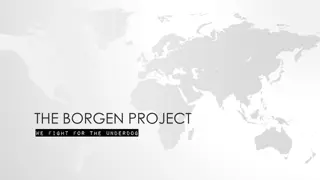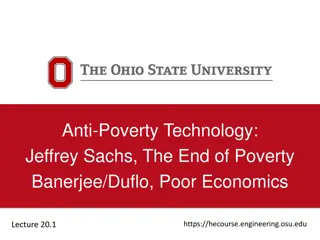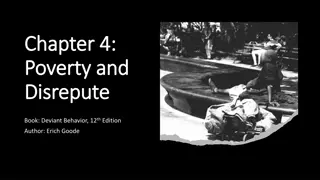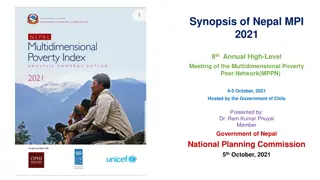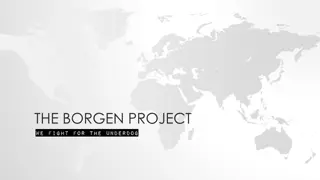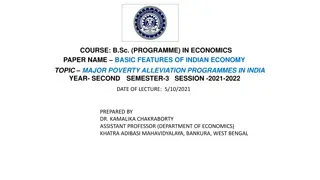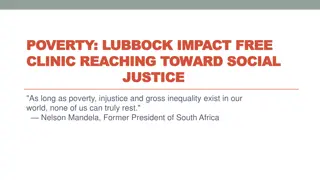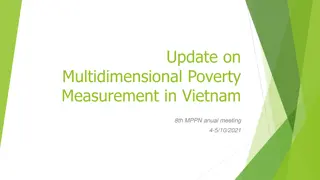Uncovering the History of Poverty Point: Study Questions
Explore the fascinating world of Poverty Point through study questions that delve into topics like its significance, location, historical context, and the complexity of mound building. Discover how this ancient site was a hub of activity amidst a changing global landscape, shedding light on early American Indian cultures and monumental earthworks.
Download Presentation

Please find below an Image/Link to download the presentation.
The content on the website is provided AS IS for your information and personal use only. It may not be sold, licensed, or shared on other websites without obtaining consent from the author.If you encounter any issues during the download, it is possible that the publisher has removed the file from their server.
You are allowed to download the files provided on this website for personal or commercial use, subject to the condition that they are used lawfully. All files are the property of their respective owners.
The content on the website is provided AS IS for your information and personal use only. It may not be sold, licensed, or shared on other websites without obtaining consent from the author.
E N D
Presentation Transcript
Poverty Point Study Questions
1. What is Poverty Point? multiple mounds and C-shaped ridges In its time, it had the largest earthworks in the Western Hemisphere. Many people lived, worked, and held special events at this huge site over hundreds of years. This has led some to call it North America s first city
2. Where is Poverty Point located? located near Epps, Louisiana, in West Carroll Parish.
3. What was going on in the world at the time Poverty Point was being built? Egypt, Queen Nefertiti and the boy pharaoh, Tutankhamen, ruled. In Britain, Stonehenge was being finished. In China, the Shang Dynasty was flourishing. In Mexico, the Olmec were rising to power. In India, the Rig Veda, the oldest of Hinduism's sacred books, was being written. most American Indians north of Mexico lived in small, mobile bands of hunters and gatherers
4. Poverty Point Indians than others around them during this time? most American Indians north of Mexico lived in small, mobile bands of hunters and gatherers At Poverty Point the people were hunters and gatherers, but they lived year-round in a large community. They built earthworks and made tools and decorative objects with rocks and minerals brought from afar. What were some differences in the
5. ___American Indians__ made the site's first mounds around __1700 B.C. ____, during the __Late Archaic _____ period.
6. How long did the earth work tradition last? about 600 years
7. In that time, people moved nearly _2_ million cubic yards of earth to make the site. Assuming a large dump truck can haul 52 cubic yards of earth, it would have taken about _38,462_ dump truck loads of dirt to make Poverty Point!
8. The Poverty Point site serves as proof that mound building in the eastern United States was very ______complex______.
9. Why did Native Americans come to Poverty Point? Some came to exchange goods and news or to meet people. Others were attracted by the site's natural resources. Still others came to create the site's mounds and ridges or to take part in ceremonies. Most probably had deep family ties in the area.
10. What mounds were built? Put them in chronological order and tell about each one. 1. Mound B is the oldest earthwork at Poverty Point. The mound even predates the site s most unique features, its C-shaped earthen ridges. At this time, people were living in the area on which they later built the ridges 2. American Indians built Mound E shortly after finishing Mound B. They also started building the site s ridges. In the northeast part of the plaza, people started using the space where they would soon build Mound C
3. By the time people built Mound C, trade and ceremony at the site were well under way. Upkeep of the site would have been an ongoing task. 4. American Indians built Mound A around 1350 B.C., making the mound in three stages. Mound A was the largest of the site s mounds, requiring millions of baskets of dirt to make.
5. American Indians built Mound F sometime around 1200 B.C. It was the last mound built at the site during the Late Archaic period. 6. American Indians built Mound D around A.D. 700. It was nearly 2,000 years since the last mound was built at the site. The people who built Mound D were probably the descendants of the earlier earthwork builders.
11. What river was the Poverty Point site built on? Bayou Macon
12. ___Rivers__ were the highways of the ancient world. What were they used for? Trade, travel, transportation, source of food
13. What was one major problem with the Poverty Point site? there were no rocks near the site. This would have been a problem for people who relied on stone tools.
14. People used ____dugouts____ to travel and haul their goods along these waterways.
15. How was stone used at the Poverty Point site? Was it valuable? make stone spear points. used stones and minerals to make decorative items, made of lead ore called galena made some tools like very small hand tools called microliths many people used stones for cooking
16. What is the most common artifact found at Poverty Point? What was it used for? Poverty Point Objects (PPOs)
17. One reason people built the site where they did was because __food__was so abundant nearby. Natural wetlands, grasslands, woods and rivers surround the site. These areas offered people a rich and varied diet.
18. What kinds of plant food were found at the Poverty Point site? persimmons, pawpaws, muscadine grapes, and nuts such as pecans and black walnuts herbs
19. What other types of food did the Poverty Point Indians eat? people ate deer and lots of small animals like fish, squirrel and turtle
20. Give reasons why not many animal bones are found at the Poverty Point site probably used bones to make tools Soil does not preserve bones well
21. What are plummets? teardrop-shaped stone weights found important fishing gear could have used these as weights on fishing nets
22. Why did American Indians build the mounds at Poverty Point? No one really knows for sure Could be ceremonial Built ridges for living purposes Served as the first North American city
23. Have there ever been any burials found at Poverty Point? no
24. What kind of religion did the American Indians of Poverty Point practice? We do not know
25. Why did the American Indians who built Poverty Point use spears and darts instead of bows and arrows? Bow and arrow had not been invented yet Spears and darts served the needs of the people who lived at Poverty Point just fine.
26. What do we know about ceremonial life of the Poverty Point Indians? the plaza offers one of the best looks at ceremonial life at the site found within some of the mounds are the remains of fire pits and possible postholes. These could be the remains of buildings or ceremonies that people held on the mounds.
27. What were Poverty Point figurines? Why is it so hard to tell what the figurines are meant to be? Poverty Point figurines could be statues of ancestors, magical charms, or even toys. Archaeologists largely rely on patterns and context to understand the past. The figurines come in a variety of forms and have not been found with other things that give clues to their use. This makes it hard for archaeologists to interpret them.
28. People living at the site would have been able to get almost anything they needed through __trade___, including __news__.
29. In the Late Archaic period, most people lived in __small groups___. This was not the case at the Poverty Point site. At its peak,__hundreds__ of people lived at the site, maybe more
30. What is an anthropologist? people who study human culture
31. Why were the ridges built? What is a causeway? There are six ridges in total. Each ridge is divided by four aisles that extend from the plaza. The highest ridge stands over 6 feet tall. The lowest ridges, to the south, are less than 1 foot tall. American Indians built some of these ridges in stages and others all at once A narrow rise that crosses a shallow depression outside the southwestern section of the ridges is called the causeway. The causeway is about 295 feet long and almost 50 feet wide, but probably originally went across the entire depression. Perhaps it was the path people used to get the soil for maintaining the plaza
32. What was the Plaza? people built the site's 43-acre plaza by hand just like the mounds and ridges. People started building the plaza around the same time as the site's ridges, or perhaps only slightly later The wide-open plaza offered a great view of the site, which could have made it an ideal meeting place.
33. What were the docks? The dock would have provided an easy route for people to reach the site from the Bayou Macon. This was important because the bayou was used for trade, travel and fishing.
34. What was an Atlatl? The atlatl, or spear thrower, is an ancient tool that gave thrown spears extra power and speed
35. What was a Gorgets? flat, oblong stone artifacts ornamental or wearable art.
36. What is daub? What was it used for? Daub is mud that people packed against a framework of woven sticks to make the walls of a house. Packing the weave with mud gave it more support and insulation.
37. What are Microliths? What were they used for? tiny stone tools Archaeologists refer to some microliths by more specific names, like perforators or blades, based on the shapes of the tools or how people used them. Blades are long, thin microliths that people used for cutting, drilling and scraping.
38. One of the most unusual artifact types researchers have found at the site is the red jasper "pot-bellied" owl pendant. These ground stone pendants are very rare, only 30 were found in the United States
39. What were the pipes found at Poverty Point used for? tubular pipes made of clay and stone at the site. Pipes like these may have been smoked for special events, like rituals or ceremonies. shamans or priests may have used them as "sucking tubes" to suck illness, objects or bad spirits from people
40. The people at Poverty Point were among the first in Louisiana to use ____pottery_____. American Indians also made __pottery_ at Poverty Point.
41. What was added to the pottery, so that it would not crack while being fired? Plant fibers and Spanish Moss
42. What were cooking stones? List the types of cooking stones Molded clay used for cooking Types of cooking stones: biconical, cylindrical grooved, cross grooved, and melon shaped.
43. Describe the cooking process People molded PPOs by hand and heated them until they became ceramic. The hardened PPOs worked a little like charcoal briquettes. Someone dug a fire pit, placed the PPOs in the bottom, and built a fire on top of them. After the fire died down, the food could be wrapped in leaves, put on the heated PPOs, covered with dirt, and left to roast or steam. That is called an earth oven, and the heat of the oven could be controlled by varying the number and placement of PPOs. Hot PPOs also could have been used as "boiling stones" to heat food in containers.
44. What were Projectile Points? Different types of Projectile Points? Projectile points are the chipped stone spear, dart or arrow tips that ancient peoples made Most of these were made from rock brought from afar. The imported rock came in many colors and textures Types of Projectile Points: These are the sorts of stone points hunters used with lightweight spears and atlatls (spear throwers). Arrow points are much smaller and lighter
45. Why have researchers found more spear points that arrowheads? they have found far fewer arrowheads than spear points. This is because American Indians did not adopt the bow and arrow in this area until around A.D. 700.
46. What were soapstone bowls? The people who lived at Poverty Point cooked and stored food and other things in soapstone vessels The stone for these bowls came from quarries in what is today Georgia and Alabama Craftspeople sculpted the bowls at these quarries and sent them out for trade only after they had been carved. It is much more efficient to transport a hollowed-out bowl than a block of stone.
47. How did the American Indians of Poverty Point dress? We do not know. People at Poverty Point probably wore clothes made of animal hide or woven textiles made from plant or tree fibers. Color dyes from plants, bug shells and minerals could have been used to color their clothes and skin. Tattooing could have also been popular. Some of the objects found at the site, like beads, pendants and gorgets, could have been worn like jewelry or sewn onto people's clothing.



